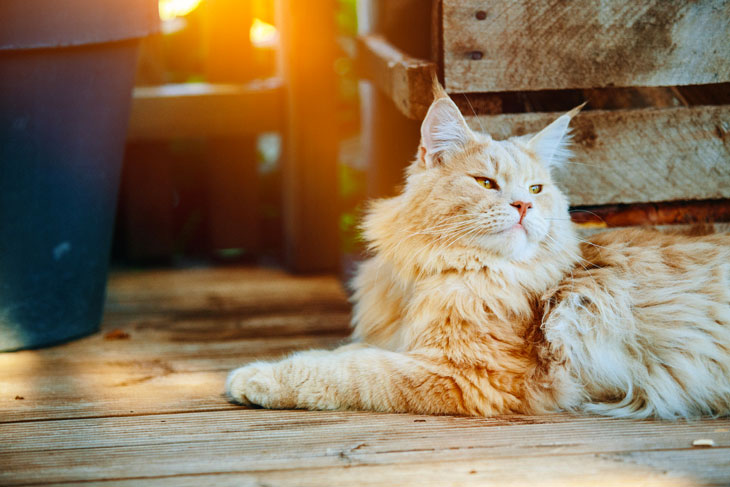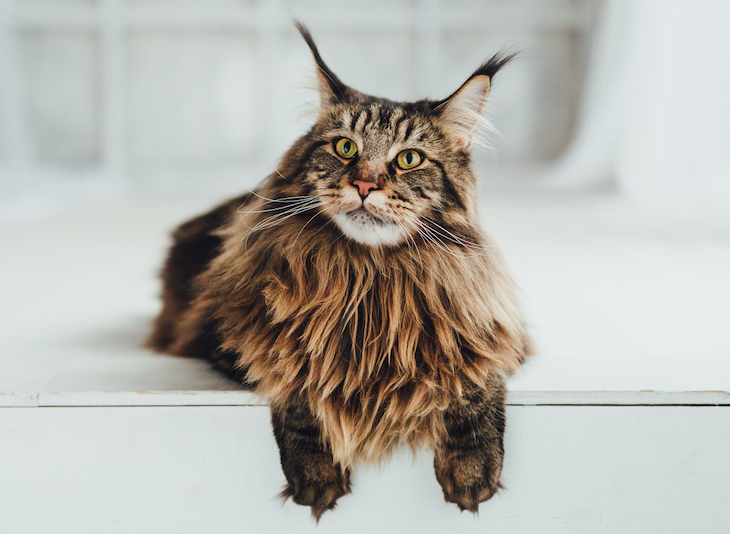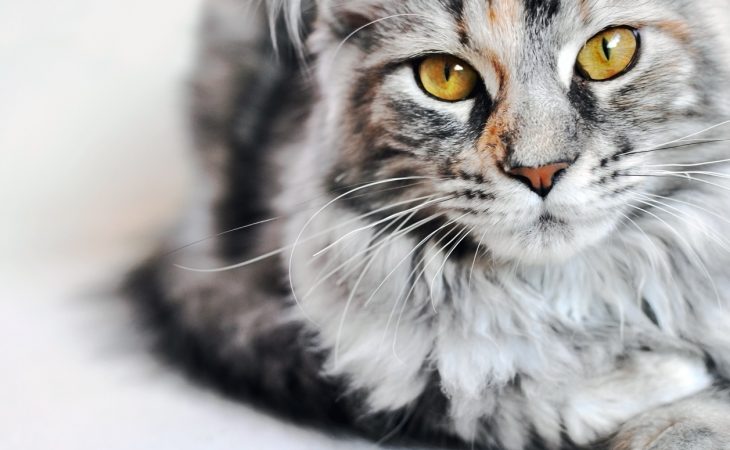The Maine Coon is a gentle, playful, curious and affectionate cat breed. It is also one of the world’s largest cat breeds!
Breed standard: CFA, FIFe, TICA, ACF, ACFA/CAA, GCCF I Size: Large I Average Lifespan: 12.5 years I Temperament: Gentle and affectionate I Coat: Medium-Long I Origin: USA
Maine Coon: the many legends of its origins
Legends and myths of the Maine Coon
The origins of the Maine Coon are to this day still debated. Many tales of folklore and mystery are still thrown about during discussions of the breed.
Legend has it that the Maine Coon was the result of breeding a raccoon with a wild cat. Whilst this might explain its luscious, thick fur, science may not see it in quite the same way. In fact, it is physically impossible for the two different species to breed!
Could the Maine Coon be French?
There are some who believe the Maine Coon descended from the Angora cats belonging to the last Queen of France, Marie Antoinette. While Marie Antoinette herself didn’t make her escape to Maine as proposed, some believe her cats may have been on one of the ships transporting her belongings to “the land of the free”.
What became of said cats is not documented, although some say that despite her execution, her cats lived on and bred with the local cats in the state of Maine.
From folklore to hypotheses
Within the realms of folklore lies, perhaps, a more plausible assertion.
There is no denying that the Maine Coon looks a lot like the Norwegian Forest Cat. Could it be that Viking blood is circulating in its veins?
This scandinavian cat is said to have been brought over to the United States on Viking ships around 1000 A.D. At this time, cats were widely used to keep rodents at bay, protecting valuable food stores for crews and any guests. Once on US soil, the Norwegian Forest Cat is said to have bred with local domestic and/or wild short-haired breeds in the Maine area.
So what truth is there to all these legends?
With no official documentation identifying the origins of the Maine Coon, it is difficult to say with certainty from whence this large breed hails. On the other hand, all domestic cat species are said to originate from ancient Egypt and the Near East, according to more recent studies. So, we may know a little more about the Maine Coon’s origins after all.
With this in mind, the Maine Coon was still officially recognized as the first purebred cat in the US, specifically ‘native’ to the state of Maine. And despite the many mysteries and legends surrounding this landrace breed, one verified truth is the worldwide popularity of the Maine Coon.

Breeding the Maine Coon
As a hardy cat and an excellent hunter, the Maine Coon became indispensable to US farmers by protecting crops from pests. Pioneers also appreciated the breed’s gentle and affectionate nature. Before long, the cat was bred and exhibited at cat shows under the name ‘Maine Cat’.
The first of these Maine cats to be recognized in literature was a black and white cat named “Captain Jinks of the Horse Marines” in 1886. The breed became very popular in the US thanks to cat shows in Boston and New York, but was quickly pushed aside within cat circles in favor of the Persian and other more exotic breeds coming onto the scene in the early 1900s. At one point, the breed was said to be threatened with extinction. Although losing its popularity for some time, this was not in fact true.
In 1950, the first official Maine Coon club was created when cat fanciers turned their attention back to this beautiful breed. In 1976, the breed was finally recognized by the Cat Fanciers’ Association (CFA).
European interest
Whether or not the Maine Coon has European roots, the extraordinary size and beauty of the Maine Coon quickly gained interest across the Atlantic. Germany was the first European country to welcome the breed to its territory. This was in 1972. Almost 10 years later in 1981, France followed suit, although the breed’s popularity only began to take off in the early 1990s.
An extraordinary cat
Part of the appeal of the Maine Coon is its extraordinary size and nature: a colossus with a tender heart, or ‘gentle giant’. In fact, the Maine Coon is one of the largest domestic cat breeds. It reaches maturity at around 3-5 years old, slower than that of other cats. As an adult, they can weigh anywhere between 4-10kg, however, some males can reach up to 14kg – a real mini Lynx! In general, females weigh about 3kg less than males and sit at the lower end of this weight spectrum.
The record for the world’s largest Maine Coon is currently held by Italian-based Barivel. Barivel measures 120cm (3ft 11.2in) long and bucks the Maine Coon trend of being on the shyer, quieter side.
Character of the Maine Coon
A Maine Coon can adapt well to apartment living provided they have been introduced to it from an early age.
The Maine Coon: its qualities
Appropriately named, ‘gentle giant’ Maine Coons have a very sweet, kind and patient temperament. They respond well to children and even other pets. They will require regular affection from their owner and may want to play often. Leaving them alone for long periods is not recommended.
These ‘gentle giants’ are vocal creatures and enjoy communicating with their owner. Don’t be surprised by their chirp-like meow (or coo); it’s a more unusual sound than the common cat makes. They have also been described as ‘dogs of the cat world’, being friendly, intelligent, playful and curious. It’s even possible to teach them tricks like ‘fetch’!
Maine Coons love being outdoors but will adapt well to indoor living providing they have sufficient stimulation and human interaction. Usually, it is best to allow for this adaptation from a young age. They also enjoy exercising, so if you don’t have a garden you may like to walk them on a leash.
Unlike most cats, Maine Coons are typically fascinated by water and may enjoy going for a swim in the summer. You may find them happily taking a swim in a swimming pool, lake, or even bathtub. Who’d have thought it!
Are there any downsides to having a Maine Coon?
Safe to say, Maine Coons make for one of the most loving and enjoyable cat breeds. The main consideration is to ensure that they receive enough attention from you. Unlike some other cat breeds, Maine Coons are slightly less independent. So, ensuring you have plenty of quality time together will be a must.

Physical characteristics of the Maine Coon
Did you know that the record for the longest cat in the world is held by a Maine Coon? Known as Stewie, he measured 123cm in length, from nose to tail!
General appearance
Long and muscular, Maine Coons are one of the largest and longest cat breeds in the world. The breed sports a solid bone structure and impressive muscles. The body is rectangular in shape and features a broad chest, while the tail is long and covered in thick, long fur. The coat is medium-long and of uneven length and particularly prominent on the back and flanks.
One of the Maine Coon’s most distinguishing features is the small tuft or feather-like strands of fur at the tips of the ears.
Zooming in on the Maine Coon’s head
The head is of medium size featuring high and prominent cheekbones. The muzzle is noticeably square-shaped and thick, with a strong, defined chin. The nose, chin and lips are aligned on the same vertical. Looking at the profile, the nose forms a slight concave, or ‘ski slope’ curve. According to breed standards, this profile should not show signs of having a “break” or “stop”.
The forehead and crown are prominent and elegant, and almost regal in appearance.
Eyes are large, oval and spaced reasonably far apart. They are typically green-yellow or copper-gold, although colors accepted by the breed standard include green, gold, copper and yellow. Blue or odd-colored eyes are only accepted with a white coat.
Ears are large and stand tall on the head. They are broad at the base and are often likened to the ears of the Siberian and lynx breeds, who also sport feathered tips.
According to breed standards, it is essential to have a balance of proportions between the head and the length of the muzzle.
The body of the Maine Coon
Breeding standards ensure Maine Coons maintain an overall balance within their body framework. As a large cat breed, they are also remarkably long. Strong muscles and a broad chest help to support their framework.
A Maine Coon’s legs are powerful and muscular that feature large, rounded paws. As a relatively tall breed, their rectangular shape is noticeable, particularly when sitting.
The paws feature five toes at the front and four at the back. There is also a significant amount of hair between the toes.
The ideal length of the tail should reach to the base of the shoulder blades. It is broad at the base and thick with long hair that forms supple strands, tapering to a pointed end.
LOOF eligibility criteria
According to the LOOF, the French Livre Officiel des Origines Félines (or Official Register of Feline Origins), competing Maine Coons in registered events must meet official LOOF standards. The following criteria is laid out on their website.
Non-eliminating criteria
These defects may result in penalties:
- Straight profile, “stop”, “brake” or pronounced bump on the nose.
- Receding chin receding, lacking in depth. Muzzle short, long or pointed.
- Short, stocky body or fine bone structure.
- Short winter coat or of equal length over the whole body.
- Little or no inter-toe hair.
- Woolly undercoat.
Elimination criteria
These defects will result in exclusion from the competition:
- White spots (except in the colored areas).
- Polydactyly – presence of one or more additional finger(s).

Coat, color and grooming
Maine Coon coat
The Maine Coon has a very fine, full coat that contributes to their overall size and magnificence. The coat is medium-long, thick and dense all over the body. It is characterized by two distinct layers – longer guard hairs on the outer with a silky satin undercoat. Overall, the hairs are very fine, soft and silky, but they protect well from its native colder climate.
The fur can become tangled easily, especially on the belly area and under the armpits so regular grooming will be required.
Maine Coon colors
Coat colors vary widely and can be categorized into 5 groups:
- Single-colored: white, black, blue, red, cream.
- Tortoiseshell: tortoiseshell, blue cream.
- Tabby: blotched tabby (most common coat), mackerel tabby (tiger).
- Silver and ‘smoke’: silver tabby, smoke tabby.
- Parti-color: bicolor and tricolor, Harlequin (rare), Van (rare).
Maine Coon grooming tips
A Maine Coon’s coat will require regular grooming to maintain is lusciousness and remain tangle-free. This is also important for their health. While grooming, cats swallow a reasonable amount of hair. Knots and matted areas can cause intestinal discomfort, or in worse but more rare cases, get lodged in the intestines.
To avoid a matted-looking cat, it’s recommended to brush a Maine Coon 2-3 times per week, if not daily. This is best started from a young age so as to accustom to the cat to the routine. A soft bristle brush is advised to avoid static electricity, and care should be taken so as not to damage the coat. Ultimately, the goal is to gently remove any knots or matted areas to ensure they don’t become unruly or of concern to your cat.
In the fall and spring, your cat will molt. During this period, it is best to increase the frequency of brushing. Once a day may sometimes be necessary to get rid of dead hair.
Another option is to bathe your cat. As a breed that is more comfortable around water, this can be done 3-4 times per year using the right cat shampoo (never use shampoo for humans!). Similar to grooming, bathing is best introduced from an early age so that your cat is well-versed on the routine. You can talk to your vet about tips and tricks for bathing and suitable cat shampoos available.
The Maine Coon at a glance
Size: This is a large cat breed. Maine Coons can weigh from as little as 4kg up to a staggering 14kg!
Health: Maine Coons are a generally strong and healthy breed with a low health concern risk. That said, inbreeding can lead to certain ailments such as cardiomyopathy or hip dysplasia. Therefore it’s important to ensure that your breeder is registered, carries with them relevant industry certifications, and has a known and respected reputation.
Are Maine Coons good with children? This is a very patient cat breed that will make an ideal companion for children. As always, it’s important for children to remember that a cat is not a stuffed toy!
How easy are Maine Coons to live with? As the dog equivalent of a cat, Maine Coon owners will need to ensure they have time for their ‘gentle giant’. We’ve learnt that Maine Coons are wonderful, affectionate cats, making them a delight to live with. However, they will require your regular presence to avoid feelings of isolation and fear. If your work commitments see you regularly away from home, especially for long periods of time, then this breed won’t be suited to you. If you live in an apartment, adopting a Maine Coon from an early age will help your kitten adjust to this lifestyle as it grows. Also ensure your cat has ample access to toys and other forms of stimulation to avoid boredom. They will also cohabit well with other pets in the home.
Did you know? Maine Coons coo in place of meowing.

